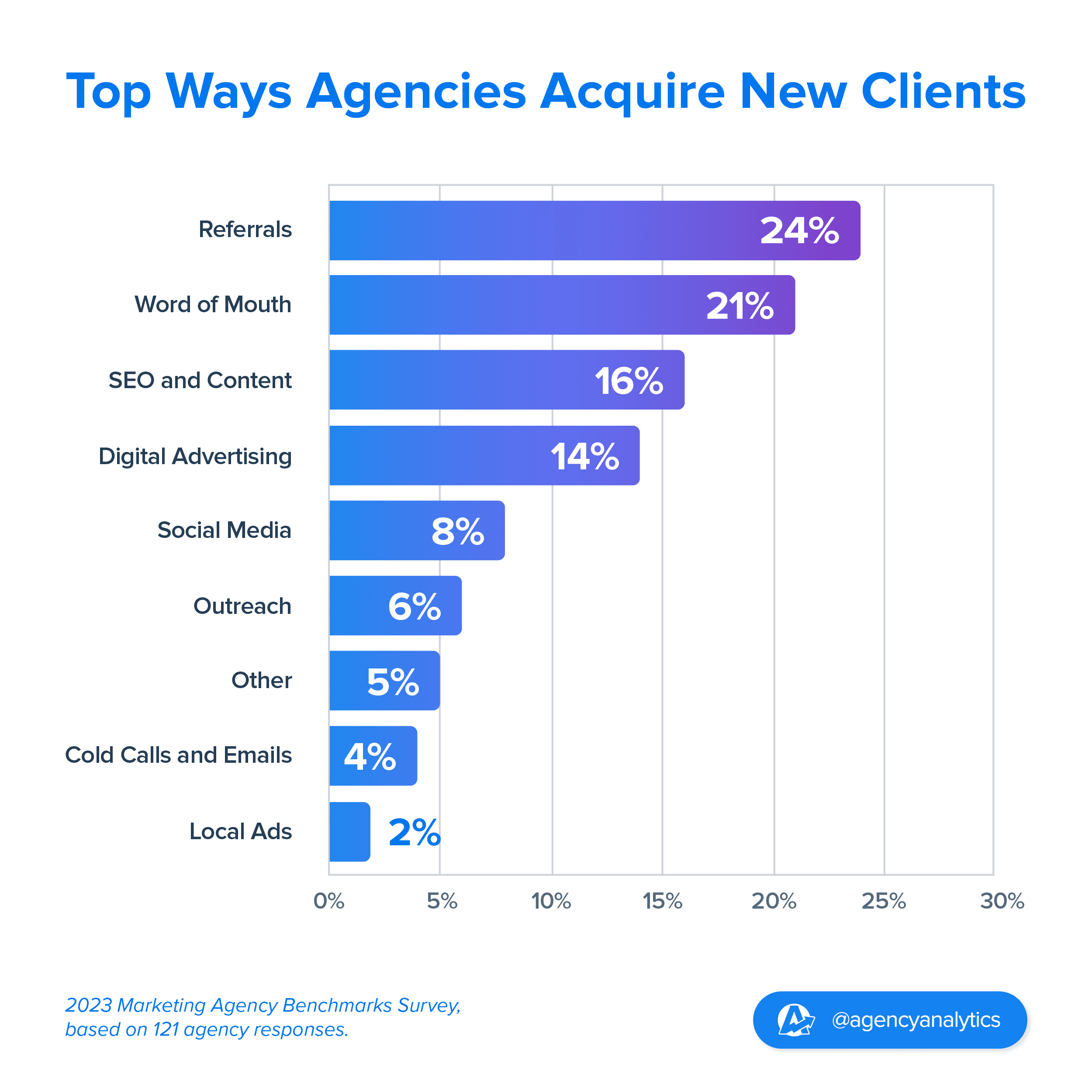Table of Contents
QUICK SUMMARY:
Struggling to set the right referral fee for your marketing agency? This article breaks down everything you need to know about referral and finder’s fees. Learn how to attract top clients, reward your network, and boost your agency's growth with clear, effective fee structures.
Your agency is nothing without its clients—and when you're able to attract and secure new business from companies that align with your agency's vision, mission, and values, that's when the real magic happens.
Acquiring great new clients means stronger partnerships, increased employee engagement, and ultimately, more revenue. What better way to find these types of companies than through the ones you're already working with, and the employees who know your agency's ideal customer profile the best?
New customers that come through a referral are typically well-suited to your agency's offerings, and are entering the partnership holding your work in high regard. So it's no wonder that nearly 1/4 (24%) of agencies name referrals as their preferred acquisition channel.

That's right, agencies want to work with businesses that hear about them through good old-fashioned word of mouth. This is why many choose to offer a referral fee, finder's fee, or another type of incentive to sweeten the deal for everyone. After all, all parties benefit from this type of business transaction.
Referral business has the highest conversion rate and yields the best-fit clients. Focussing on nurturing referral business is the best ROI marketing.
David Metcalf, Managing Director, Distl
The questions then become: Should your agency be paying referral fees? And how do you set a price?
Lucky for you, we've covered all of that and more. So sit back, relax, and take in everything you need to know about setting up a fair exchange for finding new customers through your existing network.
What Is a Referral Fee Within the Agency Context?
A referral fee is a commission paid to someone for bringing a new client or customer to your business. In the context of a marketing agency, referral fees incentivize existing clients or employees to refer potential customers to your agency. This process is a great way to find prospective customers from the right audience, and often leads to successful conversions.
Referral fees are common across various industries, from marketing, to rental property management, to online services. Typically, businesses offer a percentage of the deal value or a flat fee as a reward for the referral. That said, referral fees might not come in the form of money but as a gift, discount, or some other type of benefit.
Whatever the case, the idea is to reward the intermediary for their assistance in securing new business. By implementing a structured referral campaign, your agency will harness the power of word-of-mouth marketing, leading to more successful business transactions and higher customer satisfaction.
The biggest contributor to our growth so far has been client referrals. We have an incredibly low churn rate for an agency that’s been in business as long as we have. The first clients we started out with are still with us and we continue to help them grow and adapt to market conditions.
Matthew Regenie, CEO, Prospect Future
What Percentage Is a Typical Referral Fee for an Agency?
Marketing agencies might pay anywhere between 5% and 10% of the new client’s first project or the contract value to the referring party. This amount varies depending on the industry, the size of the deal, and the standard practices within your local market.
Example: Agencies working in higher-ticket price verticals like real estate marketing might settle on a lower fee. If you're working on multi-million-dollar property deals, 5% is a sizable amount. On the other hand, agencies in industries like ecommerce or local services that typically deal with smaller, more frequent transactions might offer up to 15% to make it more attractive. New agencies trying to scale might also offer a healthier fee with the aim of growing their business.
Finder’s Fee vs. Referral Fee
The terms referral fees and finder's fees are often used interchangeably, but they're actually different. Both types of fees reward individuals for bringing in new business, but they differ in their structure and application.
Finder's fees are typically one-time payments for locating customers or business opportunities. The 'finder' or intermediary may or may not have a relationship with either party.
Referral fees are commissions for introducing new prospective buyers or customers to a business. Usually, the person making the referral is familiar with both parties involved.
The table below highlights the key similarities and differences between these two types of fees:
Factors | Finder’s Fees | Referral Fees |
|---|---|---|
Definition | A one-time payment for assistance in finding a potential customer or business opportunity. | A commission paid for introducing a new client or customer to a business. |
Payment Structure | Generally a flat fee or set percent of the transaction's value. | Usually a percent of the first project or contract value. |
Relationship | Typically involves a third party with no ongoing relationship after the deal. | Usually involves ongoing relationships, such as existing customers or employees. |
Typical Use Case | Often used in industries like real estate where an intermediary helps locate either the rental property or buyers. | Common in agencies and other businesses seeking new customers through word-of-mouth recommendations. |
Are Referral Fees Effective for Scaling a Marketing Agency?
Yes, referral fees are effective, but their success depends on proper implementation and management. On the plus side, referral fees incentivize clients and employees to bring in new business, leveraging their networks to identify potential customers. This approach often makes for higher quality leads and more successful conversions, since the intermediary is a trusted source on both sides.
90% of our book of business has come through friends, family, and referrals. During my marketing career prior to launching my own agency, I was never thinking about building a referral network or making connections for the sake of leverage one day for my own business.
Instead, I genuinely just cared about my clients, my coworkers, and the work I was doing.
Excellence mattered to me. Respect mattered to me. I worked late. I showed up to events when I didn't have to. I checked in on clients' family members and regular lives. I went above and beyond. And I owe much of my success today to this fact.
Molly Lopez, Founder & CEO, Sparo Marketing
However, there are potential downsides. If not carefully managed, referral fees might add up quickly and become costly. There's also a risk of attracting toxic customers when an intermediary is only interested in the commission, rather than genuinely interested in recommending your services.
To keep referral fees beneficial, it's important to set clear guidelines, ensure the fees are competitive but sustainable, and regularly assess the effectiveness of your referral program. This balance will help your agency maintain a steady stream of new clients while managing costs effectively.
On that note, let's explore whether or not your agency should implement a formal agreement around referral fees (spoiler: the answer is yes!)
Does Your Agency Need Formal Referral Fee Agreements?
Yes, your agency needs a formal referral fee agreement to ensure clarity, accountability, and legal protection when paying out referral incentives. Without clear agreements, you risk having to navigate disputes over payment terms, referral qualifications, and the specifics of the set rates. A formal agreement sets expectations from the outset to avoid issues down the line.
The following table breaks down the potential risks of not having established policies regarding how and when your should pay referral fees, and the benefits of implementing clear ones at your agency:
Risks of Not Having Agreements | Benefits of Clear Policies |
|---|---|
Misunderstandings: Ambiguities regarding the referral process and compensation lead to conflicts with referrers. | Clarity: Clearly defined terms ensure all parties understand their roles, the process, what constitutes a successful referral, and the compensation structure. |
Payment Disputes: Without a documented agreement, disagreements over payment amounts and timing occur, damaging relationships. | Efficiency: Established policies streamline the referral process, making it easier to manage and track referrals and payments. |
Legal Issues: Informal arrangements might not hold up legally, leaving your agency vulnerable to claims and disputes. | Legal Protection: Formal agreements protect your agency by legally outlining the obligations and rights of all parties. |
Reputational Damage: Mismanaged referral arrangements harm your agency’s reputation, deterring future referrals. | Trust Building: Transparent agreements foster trust with referrers, enhancing your agency’s credibility. |
How To Decide on a Referral Fee (6 Factors To Consider)
Before anyone gets paid, you'll have to set a price. Deciding how much a good referral is worth at your agency is tricky, but essential for all of the reasons laid out in the section above. Here are some factors you'll want to consider when setting your rates:
1. Internal vs. External Referrals
A referral might come from either an external or internal source. Your existing clients might refer other companies or professionals from their network, or members of your staff might refer a friend, former colleague, or other contacts and the businesses they work for.
When our customers are able to grow and achieve their goals, they share their experiences with other business owners. We’ve grown our business off of referrals almost exclusively.
Anya Curry, CEO, Ambidextrous Services
Both of these are valuable, but for different reasons. Your customers have a sense of the value your agency provides to them, and are objective in the sense that they don't represent your agency. On the other hand, an employee has a grasp on the types of organizations your agency wants to work with, but might also be biased as a representative of your team.
So, how do you decide on an appropriate fee for each type of referral? This will ultimately depend on your agency's structure, context, and objectives.
Example: If your customers operate in high-value industries, they're likely able to connect you with other high-value businesses, so you might offer a higher fee for a referral that comes from a client's industry network. That said, some agencies might opt to give a higher rate to their staff members instead. This could be to reward employees for their hard work, improve morale and develop a stronger agency culture, or simply to show appreciation.
2. Current Cost per Sale
Having a grasp of your agency's average cost per sale helps you determine how much is affordable for a referral without compromising your agency's margins and overall profitability. Start by calculating the average cost of acquiring a new client through other channels, and use that as your benchmark. You'll want to establish a fee that's equal to or lower than the costs associated with capturing leads in the ways you do currently.
Keep in mind, you might be willing to pay a higher price for the business that comes to you through referral. If the companies are high value and likely to lead to long-term, fruitful partnerships, it could be worth the extra cost. So be sure to balance the customer acquisition cost (CAC) against the potential customer lifetime value (CLV).
As a marketing agency we’ve very rarely marketed ourselves. Rather it has been referrals from our clients to others that has allowed us to develop and maintain client relationships.
We’ve never treated clients like they are just a number, instead we meet in-person, talk on the phone, email and Zoom. The key to developing strong client relationships is in communication.
Kevin Watts, President, Raincross
3. Payment Terms for Client Projects
Consider the payment terms you've established in your agency's client contracts and use that to inform the terms of referral payments. If your projects typically involve upfront payments or phased payments, align your referral fee payment structure accordingly.
Example: If you receive an initial deposit from a new client, you could pay the referral fee from this amount. Alternatively, if payments are spread out over the project’s duration, consider splitting the referral fee payment into installments.
4. Length of Project and Sales Cycle
The length of your agency's typical projects and sales cycles will also influence your referral fee structure, so take a peek at your most recent customer journey mapping. For longer cycles, a percentage-based fee might be more appealing as it grows with the project’s value. For shorter cycles, a flat rate might be simpler and more attractive than a referral fee percentage. Evaluate how long it takes to close a sale and deliver the work, as this will impact the timing and size of the referral fee.
Example: A year-long digital transformation initiative for a large corporation would be well-suited to a percentage-based fee. As the scope of the work inevitably expands, it ensures the referrer is fairly compensated as the project's value increases over time.
Meanwhile, short-term projects like one-time social media campaigns or quick website redesigns might be better suited to a flat fee. For a straightforward business transaction, it's practical and makes sense that the referrer would get paid swiftly and at a set rate.
5. Structuring Referral Fees
Of course, you'll have to decide on the structure you want to set for your referral fees. It could be a flat rate, a percent of the contract's value, or a hybrid model. Here's how each one works:
Flat Rate: A fixed amount paid for each referral that leads to a new client. This model is straightforward and easy to manage, and flat fees are well-suited for agencies with standardized services and pricing.
Percentage-Based: A percent fee assigns part of the value of the new client’s first project or the total contract value. This model aligns the referrer’s reward with the value of the business they bring in, making it attractive for high-value projects.
Hybrid Model: Combining a flat rate with a percent, this model offers an initial fixed payment plus a percent of the project’s value if it exceeds a certain threshold. This approach is essentially the best of both worlds, ensuring fair compensation with an added advantage for a high-value referral.
There's also the option of offering a reward in the form of a gift or discount. These are good options to keep in mind, especially if you have limited resources or want to show appreciation for long-time business and ongoing loyalty. A discount might also be a great upselling incentive for an existing client to continue working with your agency—helping to boost their lifetime value and drive ongoing success.
As a relatively new agency, we have had to compete with more established agencies with larger budgets and marketing teams. To overcome this challenge, we have focused on building relationships with potential clients and demonstrating their expertise through case studies and testimonials. The ability to be more agile, adopt new technologies, and ensure effective implementation gave us an advantage over our competition.
This while always retaining a focus on providing a high level of customer service and support to our existing clients. This has helped us to retain clients and generate positive word-of-mouth referrals.
Ben Paine, Managing Director, Digital Nomads HQ
6. Balancing Mutual Benefits
Finally, it's important that you strike the right balance between offering an attractive incentive and keeping things sustainable for your own business. The goal is to find a setup that makes for a fair exchange that's a win-win-win for all parties—the new client, the finder, and your agency.
You might decide to launch an initial referral campaign as a test, and then track the results and gather feedback to evaluate how effective it is. If one person is very satisfied but someone else feels lukewarm, it's a good indicator that there might be an imbalance in the setup.

As new leads land in the pipeline, track their progress with a Hubspot dashboard. Create yours in 11 seconds flat with Smart Dashboards from AgencyAnalytics–try it free for 14 days!
Making Referrals a Part of Your Agency’s Winning Strategy
In the competitive world of marketing, it's essential to hone in on what sets your agency apart and helps you win. One effective approach is offering referral fees as part of a broader marketing strategy. Partnering with companies that align with your values and ambitions not only brings in new business but also strengthens existing relationships. These referral partnerships provide a win-win situation, making it easier for everyone involved to see the benefits.
Understanding how referral fees work can significantly impact your agency's success. A well-structured program can motivate your sales team (by giving them stronger leads to work) and collaborators (by offering a tangible reward. While some agencies may consider a lower referral fee to keep their costs down, it’s important to balance this with the value the partnership brings. By carefully designing your agency's referral programs, your agency maximizes both new business opportunities and the quality of these collaborations.
When done right, referral strategies are beneficial for everyone involved. By following the tips and guidelines outlined in this article, your agency is sure to succeed—with a little help from your friends.
FAQs About Agency Referral Fees
Still have questions about agency referral fees? Don’t worry—we’ve got you covered.
A typical referral fee for marketing agencies ranges from 5% to 20% of the project’s value. Some agencies go as high as 25% for high-value clients or strategic partnerships. The exact rate depends on factors like the scope of work, the quality of the referral, and the amount of sales effort required after the introduction.
Referral fees can be either one-time or recurring, depending on the agreement. One-time fees are common for project-based work, while ongoing commissions work better for long-term retainers or subscriptions. Choose the model that best aligns with your services and the value of the referral over time.
Yes, a formal referral fee agreement is essential to avoid confusion or disputes. It should clearly outline payment terms, scope, timelines, and conditions for earning the fee. A written contract protects both parties and ensures everyone’s expectations are aligned.

Written by
Kyra Evans is the Manager of Content Marketing at AgencyAnalytics. She has over 15 years of experience writing content for SaaS, tech, and finance brands. Her work has been featured by HuffPost and CBC, and she serves an engaged social media readership of over 30,000 community members.
Read more posts by Kyra EvansSee how 7,000+ marketing agencies help clients win
Free 14-day trial. No credit card required.





